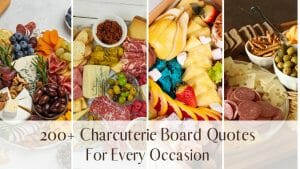Are you ready to embark on a culinary adventure like no other? Imagine savoring gourmet delights on the go, whether you're hiking in the mountains, strolling on the beach, or jetting off on a plane. In this guide, we'll unravel the secrets to creating the perfect travel charcuterie board. We'll dive into the essentials, explore themed boards inspired by destinations around the world, and share tips for keeping your ingredients fresh and delicious on your journey. Whether you're a seasoned foodie or just looking to elevate your travel snacking game, get ready to learn, indulge, and share the joy of travel charcuterie. Let's pack our bags and flavor the adventure ahead!
TIP: Become a charcuterie artist with the help of 514K enthusiasts and professionals. Click here for quick, easy lessons and community support >>
Table of Contents [CLICK HERE TO OPEN]
- What is a Snackle Box?
- Why Use a Snackle Box?
- Building Your Travel Charcuterie with a Snackle Box
- Packing Your Snackle Box
- Recommended Equipment: Elevate Your Charcuterie Experience
- Creative Presentation and Themes
- On-the-Go Charcuterie for Specific Occasions
- Tips for Enjoying Travel Charcuterie
- Safety and Food Hygiene
- Wrapping It Up
- Frequently Asked Questions
What is a Snackle Box?
As we delve into the world of crafting travel charcuterie with a “snackle box,” you might be wondering, what exactly is this curious creation? Well, if you're new to the term, fear not, for the “snackle box” is here to revolutionize your on-the-go dining experience.
Origins of the Snackle Box:
The term “snackle box” is a clever fusion of “snack” and “tackle box,” which hints at its ingenious origins. Originally designed for the adventurous hearts who cast lines into serene lakes and rivers, the humble tackle box was a trusty companion of fishing enthusiasts. But then, someone with a flair for combining culinary creativity with outdoor practicality had a revelation. Why not repurpose this rugged container to house not just bait and lures but a delectable assortment of cheeses, meats, and condiments? And just like that, the “snackle box” was born, a testament to human ingenuity.
Versatility Redefined:
The beauty of the “snackle box” lies in its versatility. It's not just about fishing trips; it's about elevating your outdoor escapades, picnics, road trips, and even air travel. With its compartments and durability, this culinary contraption transforms into the perfect charcuterie vessel, enabling you to create, carry, and share gourmet delights wherever your journey takes you.
From park picnics with friends to romantic getaways on the beach, the “snackle box” knows no bounds. It's a canvas for your culinary imagination, allowing you to assemble a variety of charcuterie, from classic cheese and cured meat boards to themed or seasonal creations.
So, whether you're a seasoned food explorer or a curious traveler craving new flavors, the “snackle box” welcomes you to a world of tasteful adventure. It's a symbol of resourcefulness, a nod to innovation, and the key to enjoying charcuterie wherever the road may lead you. In the following sections, we'll unlock the secrets of choosing the right tackle box, packing it with precision, and creating dazzling on-the-go charcuterie masterpieces.
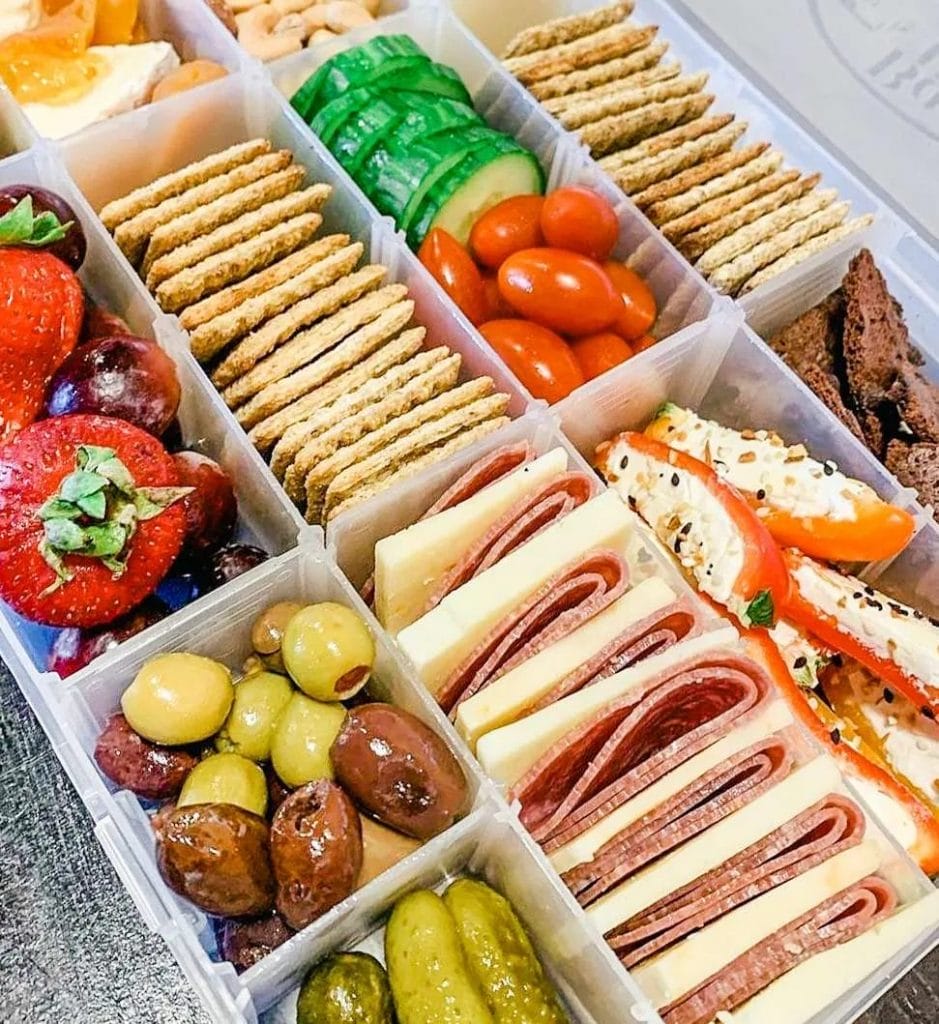
Why Use a Snackle Box?
“Why a tackle box for charcuterie?” you might ask. Well, the “snackle box” isn't just a quirky idea; it's a game-changer for on-the-go charcuterie aficionados. Here's why:
1. Ultimate Organization:
Picture this: an array of fine cheeses, savory meats, crunchy crackers, and a medley of delectable condiments. Now, imagine them all neatly arranged in their own compartments, like a deliciously orchestrated symphony. That's the magic of a “snackle box.” It's an organizational wizard, ensuring that your culinary delights stay separate and unharmed during travel.
2. Unyielding Durability:
Tackle boxes are built to withstand the rigors of the great outdoors. They're designed to protect fishing gear from water, weather, and rough handling. The same rugged qualities make them ideal for transporting your cherished charcuterie. They'll guard your cheeses and cured meats like culinary sentinels, ensuring they arrive at your destination in pristine condition.
3. Remarkable Convenience:
Ever tried balancing cheese, meats, and wine glasses on a flimsy paper plate during a picnic? It's a challenging endeavor, to say the least. The “snackle box” eliminates these culinary acrobatics. With a built-in handle for easy carrying, it turns any outing into a gourmet adventure. You're no longer confined to dining at fixed locations; the world is your charcuterie oyster.
In essence, the “snackle box” is a charcuterie companion that brings order, resilience, and convenience to your culinary journeys. It's the unsung hero of outdoor dining, making it easier than ever to enjoy your favorite flavors wherever your wanderlust leads you. In the sections that follow, we'll dive deeper into the art of choosing the right tackle box and creating the perfect on-the-go charcuterie setup.
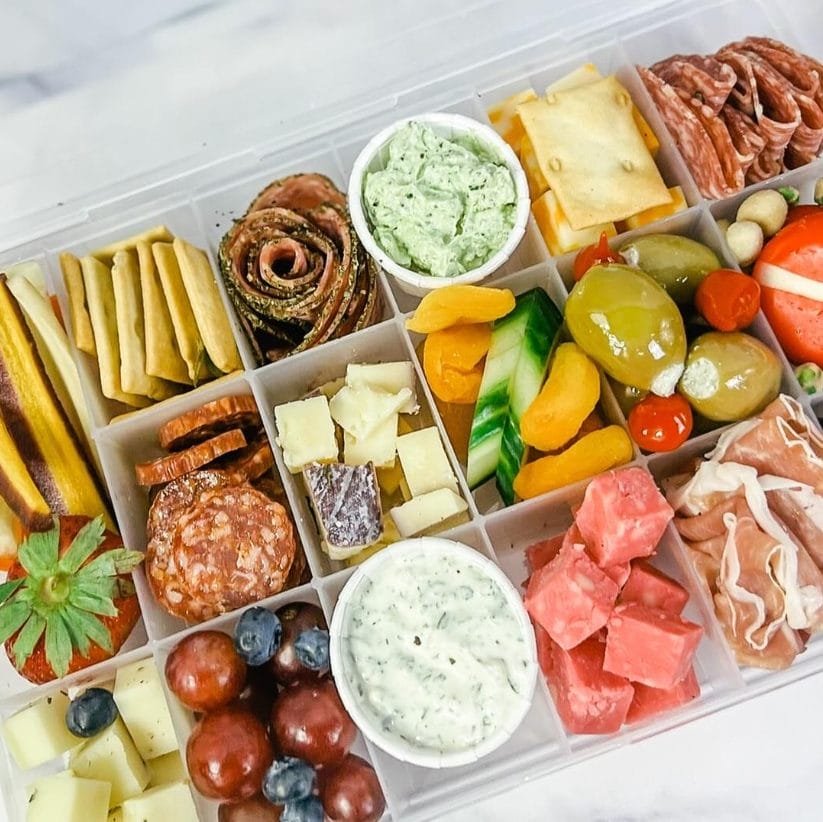
Building Your Travel Charcuterie with a Snackle Box
Choosing the Right Tackle Box
Selecting the ideal tackle box for your “snackle box” charcuterie adventure is crucial. Let's explore the features to consider and some recommendations for different sizes and styles.
Features to Look For:
- Compartmentalization: Opt for a tackle box with adjustable or removable dividers. This feature allows you to customize the layout to accommodate various charcuterie items, from cheeses and meats to condiments and utensils.
- Durability: Look for a tackle box made from robust materials that can withstand outdoor conditions. Sturdy plastic or metal construction is a plus, ensuring your charcuterie remains safe during travel.
- Sealing Mechanism: A tackle box with secure latches or seals is essential to prevent spills or leaks. It keeps your charcuterie fresh and intact throughout your journey.
- Handle: Choose a tackle box with a comfortable handle for easy carrying. Whether you're picnicking in the park or hiking a trail, the handle adds convenience to your charcuterie setup.
Recommended Sizes and Styles:
- Compact Tackle Box: A smaller, single-tray tackle box is perfect for light picnics or short trips. It's easy to carry and fits snugly in a backpack.
- Medium-Sized Tackle Box: For a more extensive charcuterie spread, consider a medium-sized tackle box with multiple trays. It's ideal for family outings or gatherings.
- Tackle Backpack: If you're planning an all-day adventure, a tackle backpack is an excellent choice. It offers ample storage space, pockets for utensils, and often includes a built-in cooler.
- Vintage Tackle Box: For a touch of nostalgia, seek out a vintage tackle box. They often have a unique charm and can be repurposed effectively for your charcuterie needs.
- Clear Tackle Box: A clear tackle box allows you to see the contents without opening it, making it convenient for quick access during your travels.
Choosing the right tackle box is about finding the balance between size, features, and style that suits your charcuterie preferences and the nature of your trips. Whether you opt for a compact, modern tackle box or a vintage classic, it'll be your trusty companion on culinary adventures. In the following sections, we'll delve into packing your “snackle box” with precision and unleashing your creativity to craft delightful on-the-go charcuterie boards.
Essential Tools and Accessories
Creating the perfect travel charcuterie setup involves having the right utensils and accessories at your disposal. Let's list what you'll need and explain how to repurpose tackle box compartments for these items.
Utensils and Accessories:
- Cheese Knives: A good charcuterie board is incomplete without quality cheese knives. Choose a variety of sizes and types, including a spreader, soft cheese knife, and hard cheese knife.
- Serving Utensils: Pack small forks or tongs for serving meats and condiments. They come in handy when guests want to savor your charcuterie creations.
- Condiment Containers: Use small containers to hold condiments like mustards, chutneys, or honey. Ensure they have secure lids to prevent leaks.
- Wine Opener: If you plan to enjoy wine with your charcuterie, don't forget a compact wine opener. Some tackle boxes have specific compartments for this.
- Cutting Board: A small, thin cutting board can be placed at the bottom of your tackle box to create a stable surface for cutting cheeses or meats on the go.
Repurposing Tackle Box Compartments:
To effectively repurpose your tackle box for utensils and accessories, consider the following:
- Adjustable Dividers: Most tackle boxes have compartments that can be customized with adjustable dividers. Use these to create sections for different utensils and accessories. For example, designate one section for cheese knives, another for forks or tongs, and yet another for condiment containers.
- Secure Latches: Ensure that your tackle box has secure latches to prevent items from spilling out during transport. This is crucial for keeping your utensils and accessories organized and protected.
- Easy Access: Place frequently used items in compartments that are easily accessible. For instance, keep cheese knives and forks in the top tray for quick retrieval.
By repurposing your tackle box compartments, you can transform it into an organized and efficient storage solution for your utensils and accessories. This ensures that you have everything you need for a fantastic charcuterie experience, whether you're by the lake, on a picnic blanket, or anywhere else your culinary adventures take you. In the following sections, we'll delve into the art of packing your “snackle box” with precision and offer tips for creating visually appealing on-the-go charcuterie masterpieces.

Packing Your Snackle Box
The art of packing your “snackle box” is a crucial step in ensuring your charcuterie remains fresh and delightful during your travels. Let's go through a step-by-step guide on how to pack your tackle box with charcuterie ingredients and include some tips for preserving freshness.
Step 1: Choose Your Ingredients:
Start by selecting your favorite cheeses, cured meats, and accompaniments. Ensure they're of high quality and that you have a variety of textures and flavors.
Step 2: Prepare Your Ingredients:
Slice cheeses and cured meats into bite-sized portions. If you're including fruits, wash and chop them. Ensure everything is ready for easy assembly.
Step 3: Organize Your Tackle Box:
Use the adjustable dividers in your tackle box to create compartments for each type of ingredient. For example, designate one section for cheeses, another for cured meats, and separate compartments for condiments, fruits, nuts, and any other accompaniments.
Step 4: Pack Securely:
Place each ingredient in its designated compartment. Ensure items are tightly packed to prevent shifting during travel. Use containers with secure lids for condiments to prevent spills.
Step 5: Include Ice Packs:
If your journey is lengthy or you're traveling in warm weather, add ice packs to your tackle box to maintain freshness. You can place them in a separate compartment or at the bottom of the box to keep items cool.
Step 6: Seal Your Snackle Box:
Close your tackle box securely. Ensure all latches are fastened to prevent any accidental spills or leaks.
Preserving Freshness Tips:
- Store perishable items like cheeses and meats near ice packs to keep them cool.
- Use a cooler bag if your “snackle box” doesn't provide insulation.
- Keep your tackle box out of direct sunlight, as heat can affect the quality of your ingredients.
- Consume your charcuterie within a reasonable time to ensure freshness.
By following this step-by-step guide and applying the freshness tips, you'll be well-equipped to pack your “snackle box” for delicious on-the-go charcuterie adventures. It ensures that your carefully selected ingredients remain in prime condition, ready to delight your taste buds at any destination. In the following sections, we'll explore the creative side of on-the-go charcuterie presentation and offer inspiration for themed and seasonal boards.

Recommended Equipment: Elevate Your Charcuterie Experience
In addition to selecting the perfect ingredients for your tackle box charcuterie, having the right equipment can make all the difference in creating a memorable snacking experience. That's why we're excited to recommend Subsafe's Charcuterie Safe: Snack Set For On The Go! Featured on Shark Tank and As Seen on Good Morning America, this innovative snack set is designed to take your charcuterie adventures to the next level.
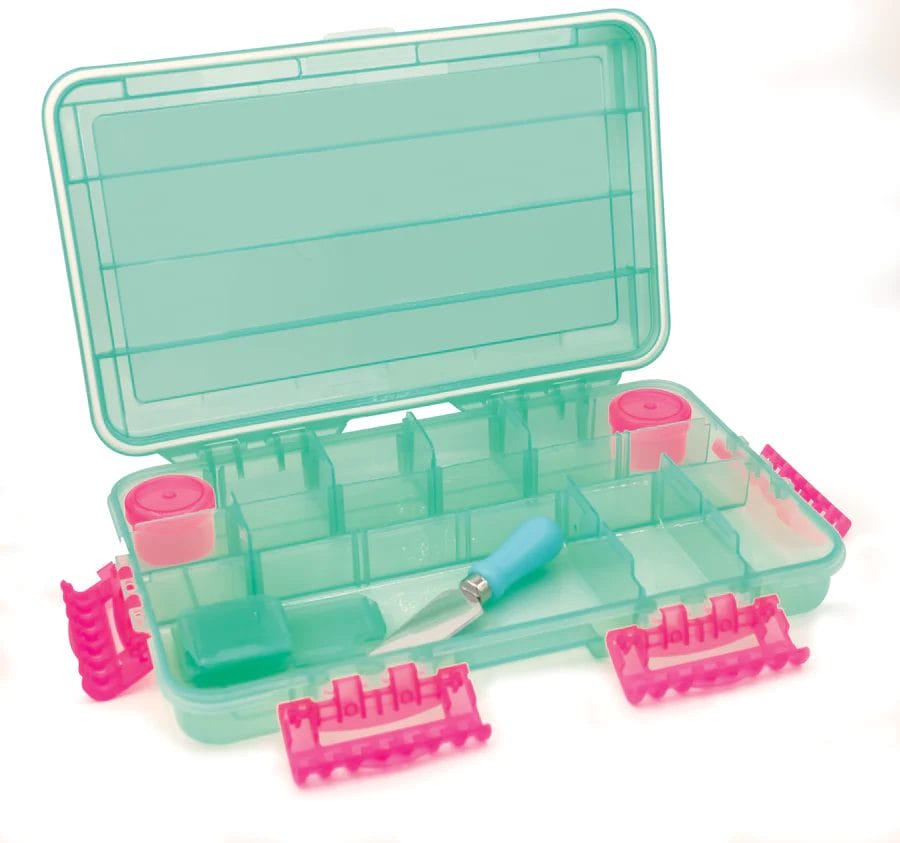
Travel-Friendly Design: The Charcuterie Safe is a food-grade safe, BPA-free “Snack Box” that's waterproof and perfect for transporting charcuterie wherever life takes you. Its watertight container, high-quality handles, and silicone ring ensure that your charcuterie stays fresh and secure, even during outdoor excursions.
All-In-One Convenience: This snack set includes everything you need for a hassle-free charcuterie experience on the go. With a cheese knife for effortless slicing, two watertight containers for spreads or accompaniments, and interchangeable walls to customize your openings, you'll have everything you need to create a delicious spread wherever you are.
Versatile and Spacious: Measuring at 14″ x 9″ x 2.5″, the Charcuterie Safe is compact enough to fit in your cooler or backpack, yet spacious enough to store all your favorite charcuterie ingredients. Whether you're planning a picnic, a road trip, or a day at the beach, this snack set is your perfect companion for any adventure.
Great for All Ages: Not just for adults, the Charcuterie Safe is also great for kids! Store plenty of snack options for the little ones without worrying about spills or leaks, making it ideal for family outings or gatherings.
Don't Miss Out – Get Your Charcuterie Safe Today!
Creative Presentation and Themes
Creating a visually appealing charcuterie within the confines of a tackle box is an art in itself. Let's explore some creative tips for presentation and offer ideas for themed and seasonal boards that will elevate your on-the-go charcuterie experience.
Making It Visually Appealing:
- Colorful Variety: Use a mix of colorful ingredients like different cheeses, fruits, and vegetables to add vibrancy to your board. The contrast in colors makes your charcuterie visually appealing.
- Layering: Create layers in your tackle box, placing some items on top of others. For example, you can layer cheese slices over cured meats for a visually interesting effect.
- Garnishes: Add fresh herbs like rosemary or basil to bring a touch of green to your charcuterie. They not only look good but also add a hint of freshness to your flavors.
- Condiment Art: Arrange your condiments in an organized and attractive manner. For instance, you can place different types of mustards or chutneys in a circular pattern for a visually appealing effect.
Ideas for Themed and Seasonal Boards:
- Mediterranean Escape: Create a Mediterranean-themed charcuterie with olives, feta cheese, sun-dried tomatoes, and tzatziki. Add pita chips for an authentic touch.
- Spring Picnic: Embrace the colors of spring with fresh strawberries, asparagus, and a selection of goat and brie cheeses. Pair it with a crisp white wine.
- Autumn Harvest: Celebrate autumn with apples, figs, and an assortment of aged cheddars and goudas. Add some honey for a sweet touch.
- Holiday Cheer: Craft a holiday-inspired charcuterie with cranberries, a variety of nuts, and seasonal spices. Include seasonal beverages like mulled wine.
- Seaside Serenity: If you're by the beach, go for a seafood-inspired charcuterie. Include smoked salmon, shrimp, and seafood spreads with crackers and a chilled bottle of white wine.
- Alpine Adventure: Imagine a charcuterie inspired by the Alpine region, featuring hearty sausages, Swiss cheese, pickles, and crusty bread. Don't forget a flask of hot mulled cider.
Your tackle box is your canvas, and the possibilities are endless when it comes to creating visually appealing charcuterie boards. Embrace themes and seasons to infuse character into your on-the-go dining experience. In the following sections, we'll explore the accessories that can enhance your travel charcuterie, tips for specific occasions, and the vital aspect of safety and food hygiene.
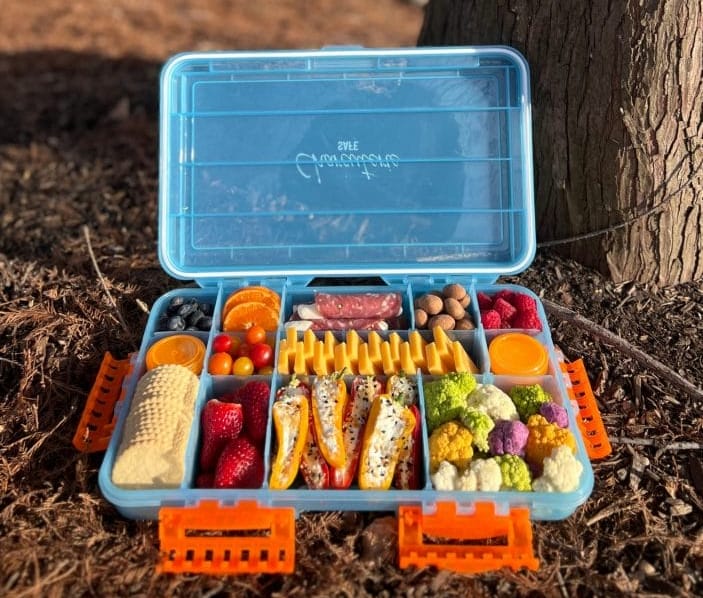
(using the Subsafe Charcuterie Safe)
On-the-Go Charcuterie for Specific Occasions
Whether you're planning a picnic in the park, embarking on a train or plane journey, or heading to the beach, there's a perfect charcuterie board waiting to accompany your adventure. Let's dive into how to create these boards and address the unique considerations for each occasion.
Picnics and Outdoor Adventures
Creating Charcuterie Boards for Outdoor Settings:
- Classic Picnic: For a classic picnic, pack a mix of cheeses (cheddar, brie, and gouda), cured meats (prosciutto and salami), baguette slices, fresh fruit (grapes or apple slices), and a jar of your favorite mustard.
- Hiking Excursion: On a hiking trip, opt for a lighter board with single-serve cheeses, beef jerky, trail mix, and energy bars. Don't forget a refillable water bottle to stay hydrated.
- Family Outing: For family outings, choose a balance of kid-friendly options like cheese cubes, pretzels, cherry tomatoes, and peanut butter for dipping.
Suggesting the Best Foods for Various Outings:
- Park Picnic: Incorporate foods that are easy to share, like small sandwiches, mixed nuts, and bite-sized veggies with hummus. Choose fruits that don't require much prep, such as grapes or cherry tomatoes.
- Hiking Trip: Opt for lightweight, non-perishable items like dried fruits, nuts, and energy bars. Portable nut butter packets are also a good choice for an energy boost.
- Beach Day: Consider foods that resist sand infiltration, like crackers, dried fruits, and sealed containers of dips or spreads. Avoid overly meltable cheeses.
Airplane and Train Travel
Crafting Compact Charcuterie Boards for Travel:
- Compact Selection: When crafting a charcuterie board for air or train travel, prioritize compact and non-liquid items. Choose single-serve cheeses, cured meats, and crackers. Pre-sliced items are more convenient.
- Condiment Packs: Use individual condiment packs or small containers to avoid liquid restrictions. Mustard, honey, and spreads are great choices.
- Security Considerations: Keep in mind that some sharp objects like cheese knives may not be allowed in carry-on luggage. You can use plastic utensils or opt for pre-sliced cheese and meats.
Beach and Seaside Boards
Creating Beach or Seaside Charcuterie Boards:
- Sandy-Friendly Choices: Since sandy environments can pose challenges, choose foods that aren't prone to blowing away or getting sandy. Snackable items like charcuterie skewers, cheese sticks, and grapes work well.
- Sandwich Alternatives: Consider making charcuterie wraps with tortillas instead of traditional sandwiches. They're easier to handle in the wind.
- Dip Containers: Use sealable containers for dips like hummus or tzatziki to prevent sand from getting in.
Specific Challenges:
- Wind: Wind can be a challenge, so select foods that won't easily blow away. Weight down lightweight items with small pebbles or shells.
- Cooling: If it's a hot day, be mindful of keeping items cool. Consider using a cooler bag with ice packs for perishable items.
Whether you're enjoying the great outdoors, soaring to new destinations, or basking in the sun at the beach, your charcuterie board can adapt to the occasion. With the right selection of foods and consideration of specific challenges, you can relish your charcuterie no matter where your wanderlust leads. In the sections that follow, we'll delve into the pros and cons of DIY vs. store-bought travel charcuterie and offer essential tips for food safety and hygiene during your culinary adventures.

Tips for Enjoying Travel Charcuterie
Enjoying travel charcuterie isn't just about the food; it's about the entire experience, from pairing with the right beverages to sharing with loved ones. Let's explore some valuable tips to enhance your charcuterie enjoyment.
Pairing Charcuterie with Wine or Beverages:
- Wine Pairing: Charcuterie and wine are a classic combination. For a balanced board, pair white wines with lighter cheeses and red wines with heartier meats. Sparkling wine or champagne adds elegance to any charcuterie experience.
- Craft Beer: If you're a beer enthusiast, consider pairing charcuterie with craft beers. The variety of beer styles allows for creative matches with different charcuterie elements.
- Non-Alcoholic Options: Don't forget non-alcoholic options like sparkling water, fruit-infused water, or iced tea. These can be just as refreshing and complement the flavors.
Serving Charcuterie to Guests or Enjoying with a Loved One:
- Sharing Experience: Charcuterie is a social food, so it's ideal for sharing. When serving guests, encourage them to explore different pairings and flavors. Explain the choices you've made.
- Romantic Setting: If you're enjoying charcuterie with a loved one, create a romantic ambiance. Use candles or string lights, play soft music, and have a selection of wines or beverages at the ready.
- Personalization: Customize your charcuterie board to cater to personal preferences. Include favorite cheeses, meats, or condiments that you and your loved ones enjoy.
Picnic Etiquette and Settings:
- Respect Nature: Whether you're in a park or on the beach, be mindful of the environment. Clean up after your picnic, dispose of trash properly, and leave no trace.
- Blankets and Comfort: Choose a comfortable blanket or picnic mat to sit on. Consider portable seating options for added comfort during longer picnics.
- Aesthetic Arrangement: Arrange your charcuterie neatly on the board or plates. Aesthetic presentation enhances the experience, and it's also Instagram-worthy!
- Consider Others: If you're in a public setting, be considerate of others. Keep music volume at a reasonable level and avoid spreading out too much.
By thoughtfully pairing your charcuterie with the right beverages, creating an inviting atmosphere for sharing with others or with a loved one, and observing picnic etiquette, you'll not only enjoy the flavors but also the entire charcuterie experience. In the sections that follow, we'll delve into the importance of safety and food hygiene during your culinary adventures and showcase the Instagram-worthy “snackle box” creations that can inspire your own charcuterie journeys.
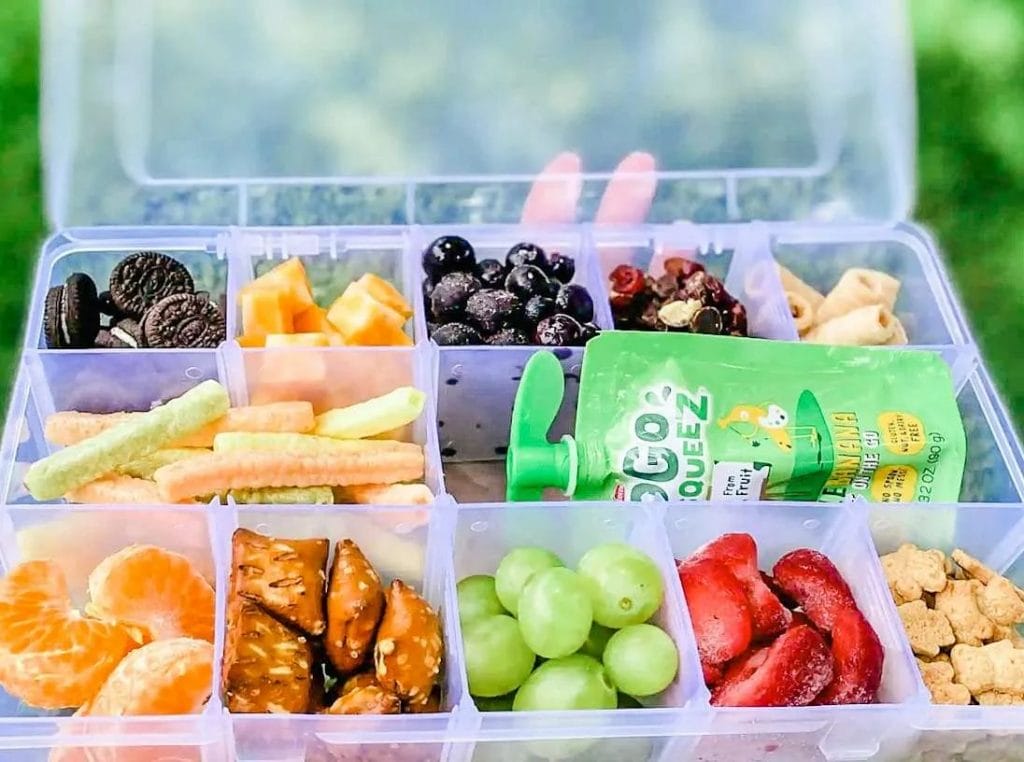
Safety and Food Hygiene
Safety and food hygiene are paramount when it comes to travel charcuterie. Let's explore detailed guidelines for safe food handling, address temperature concerns, and provide storage tips when using a tackle box. Additionally, we'll offer tips to ensure your charcuterie ingredients remain fresh during your culinary adventures.
Guidelines for Safe Travel Charcuterie:
- Clean Hands and Utensils: Before you start, make sure your hands and utensils are clean. If you don't have access to water and soap, consider carrying hand sanitizer or sanitizing wipes.
- Separate Ingredients: Use separate containers or compartments within your tackle box for different ingredients to prevent cross-contamination. Keep cheeses and meats in their own sections.
- Temperature Control: Ensure that perishable items like cheeses and meats are kept at a safe temperature. If you're traveling in warm weather, use ice packs or gel packs to maintain freshness. Tackle boxes are not insulated, so extra cooling is essential.
- Seal Containers: Use airtight containers for items like condiments or dips to prevent leaks. Check that lids are secure to avoid spills.
- Avoid Overpacking: Don't overfill your tackle box, as overcrowding can squish and damage delicate items.
- Safe Utensils: If you carry utensils, ensure they are clean and packed in a way that prevents them from touching food directly. If your tackle box has compartments with utensil holders, use them to maintain separation.
Ensuring Food Remains Fresh:
- Optimal Temperature: As a general rule, keep your charcuterie below 40°F (4°C) to prevent bacterial growth. Check and replenish your ice packs as needed during your journey.
- Use Cooler Bags: Consider placing your tackle box inside a cooler bag with additional ice packs for added insulation, especially on hot days.
- Consume Promptly: Plan your charcuterie adventure so that you consume the ingredients within a reasonable time frame. Perishable items should not be left out for extended periods.
- Hygiene Essentials: Carry essentials like wet wipes and paper towels for quick cleanups, as well as hand sanitizer for personal hygiene.
- Quality Matters: Choose high-quality cheeses and cured meats. Quality ingredients not only taste better but are often handled and stored more meticulously, ensuring better food safety.
By adhering to these guidelines for safe food handling and food hygiene, you'll enjoy your charcuterie with peace of mind, knowing that the flavors you savor are not compromised. Remember that a “snackle box” is a creative and efficient way to carry charcuterie ingredients, but maintaining safety and freshness is key to the overall experience. In the sections that follow, we'll explore Instagram-worthy “snackle box” creations to inspire your own charcuterie journeys and offer a final summary of the key takeaways from this culinary adventure.
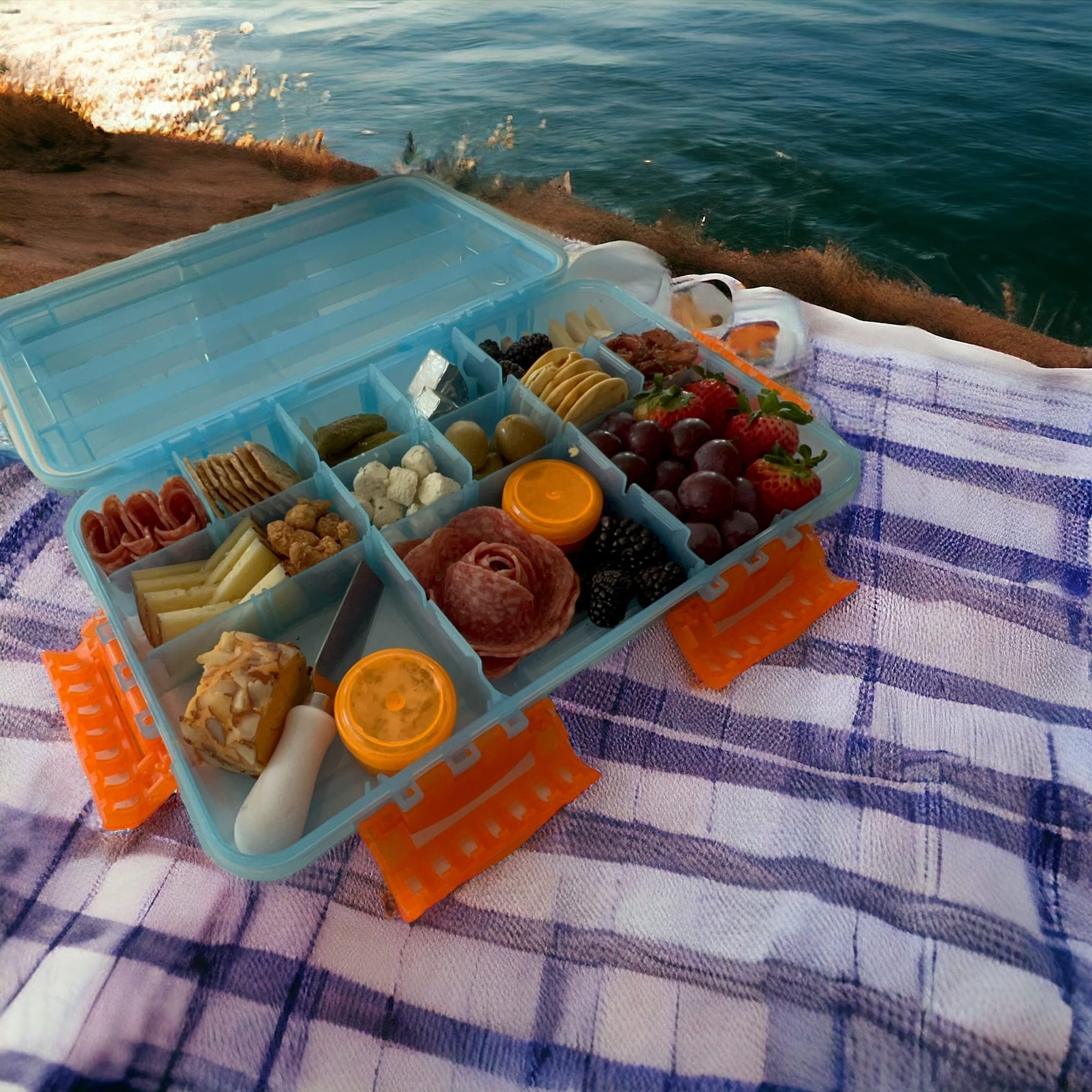
Wrapping It Up
As we conclude our journey into the delectable world of travel charcuterie boards, one thing is clear: your adventures are now intertwined with unforgettable flavors. The “snackle box” has emerged as your trusted ally, making gourmet experiences accessible wherever your wanderlust takes you. From beachside picnics to mountain hikes, from romantic getaways to in-flight indulgence, it's all about savoring life one bite at a time.
We hope this article has inspired you to embark on your own “snackle box” adventures, to create Instagram-worthy charcuterie masterpieces, and to relish the joy of sharing delicious moments with loved ones. So, pack your tackle box, choose your favorite cheeses and meats, and set forth on your culinary escapades. The world is your charcuterie board, and every journey a chance to savor the extraordinary. Safe travels, and bon appétit! 🌍🧀🍷
Frequently Asked Questions
What do you use for a travel charcuterie board?
For a travel charcuterie board, you'll need:
- A compact cutting board or a sturdy plate.
- Portable cheese knives and utensils.
- Small containers for condiments.
- Quality cheeses and cured meats.
- Fresh or dried fruits, nuts, and bread or crackers.
- A wine or beverage carrier if desired.
- Ice packs or a cooler bag for freshness on longer journeys.
It's essential to pack these items securely to keep your charcuterie fresh and enjoyable during your travels.
Can I travel with charcuterie board?
Yes, you can travel with a charcuterie board. To do so, choose portable and compact charcuterie supplies, pack items securely, and consider food safety guidelines. Charcuterie boards are a delightful addition to picnics, road trips, and other travel adventures.
How to make a travel charcuterie?
To make a travel charcuterie board:
- Choose a compact cutting board or plate.
- Select portable cheese knives and utensils.
- Pack small containers for condiments.
- Include quality cheeses and cured meats.
- Add fresh or dried fruits, nuts, and bread or crackers.
- Consider a wine or beverage carrier if desired.
- Use ice packs or a cooler bag for freshness on longer journeys.
Pack items securely to ensure your travel charcuterie stays fresh and enjoyable. Tailor your board to your taste and the occasion.
How do you make portable charcuterie?
To make portable charcuterie:
- Choose a small, sturdy board or tray.
- Pick your favorite cheeses and cured meats.
- Include accompaniments like crackers, fruits, and nuts.
- Use small containers for condiments.
- Pack cheese knives or utensils.
- Ensure items are well-sealed for travel.
- Consider a cooler or insulated bag for freshness.
This setup allows you to enjoy a delightful charcuterie experience on the go, whether it's a picnic, road trip, or a day at the beach.
Share Your Creations:
We’d love to see the charcuterie boards you create using our guide! Feel free to share your own creations in the comments or on social media, and tag us for a chance to be featured. And if you have any other ideas or tips for creating the perfect charcuterie board, we’d love to hear them.






